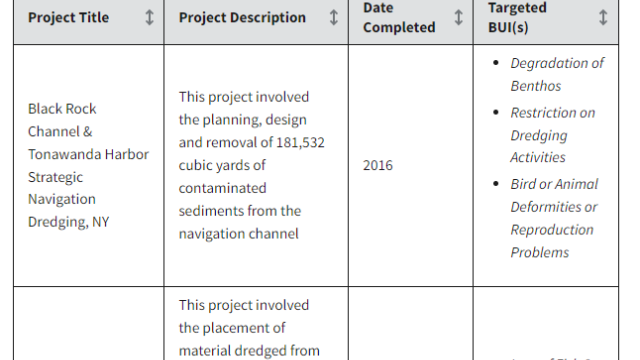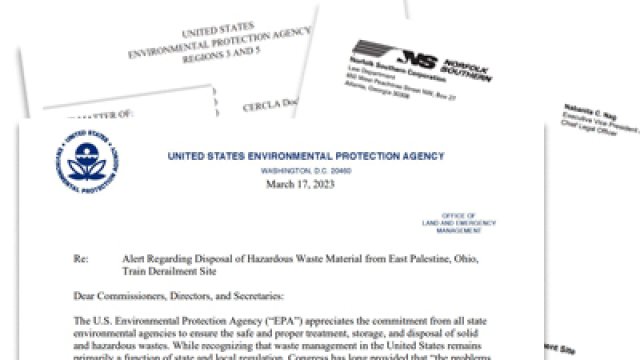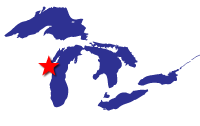Lower Green Bay/Fox River AOC
Sue Virgilio
([email protected])
312-886-4244
Overview
The Lower Green Bay and Fox River was designated an Area of Concern under the 1987 Great Lakes Water Quality Agreement and is one of five AOCs located within Wisconsin.
The Lower Green Bay and Fox River AOC is part of the Fox Wolf Watershed. The AOC spans the last seven miles of the Lower Fox River (downstream of the De Pere Dam to the mouth) and includes 22 square miles of southern Green Bay.
Portions of the AOC have experienced great environmental degradation due to land use practices. Non-point and point source discharges from industrial operations, including pulp and paper mills, agricultural land, and urban areas in the watershed have cumulatively contributed to the Beneficial Use Impairments (BUIs) in the AOC. Additionally, wetland and shoreline areas have been filled or impacted by erosion.
Several of the BUIs in the AOC are attributed to sediment contamination resulting from industrial operations. Polychlorinated biphenyls (PCBs)s generated during the manufacture and recycling of carbonless copy paper were discharged to the Fox River from pulp and paper mills. Metals and polycyclic aromatic hydrocarbons (PAHs) generated by manufactured gas plant operations were also discharged to the Fox River.
Stormwater run-off discharged from agricultural and urban lands has also contributed to excess nutrients within the AOC. As a result, harmful algal blooms are common in lower Green Bay. The toxins released by these algae raise concerns for using the Lower Green Bay and Fox River AOC as a drinking water and recreational resource. Efforts are underway in the AOC to mitigate the impacts from land use and improve human and ecosystem health.
Beneficial Use Impairments
An interim success of remediation and restoration work is removing Beneficial Use Impairments (BUIs). BUIs are designations given by the International Joint Commission representing different types of significant environmental degradation. As remediation and restoration work is completed, and monitoring demonstrates sufficient environmental health improvements, BUIs can gradually be removed. Of the 14 potential BUIs, the Lower Green Bay and Fox River AOC originally had eleven listed as present and two as suspected. Since then, three BUIs have been removed. Once all BUIs are removed, the process of delisting the AOC can begin.
- Restrictions on Fish and Wildlife Consumption
- Tainting of Fish and Wildlife Flavor - Removed April 2020
- Degradation of Fish and Wildlife Populations
- Fish Tumors or Other Deformities
- Degradation of Aesthetics (pdf) (9.4 MB, April 2022) - Removed April 2022
- Degradation of Benthos
- Restrictions on Dredging Activities - Removed September 2021
- Loss of Fish and Wildlife Habitat
- Bird or Animal Deformities or Reproductive Problems
- Eutrophication or Undesirable Algae
- Restrictions on Drinking Water Consumption, or Taste and Odor
- Beach Closings
- Degradation of Phytoplankton and Zooplankton Populations
More Information
- General information about BUIs: Beneficial Use Impairments for the Great Lakes AOCs
- State of Wisconsin Lower Green Bay and Fox River Area of Concern
Remediation and Restoration Work
The BUIs will be addressed through restoration work implemented through the AOC program. The contaminated sediment cleanup was completed in 2020. It addressed more than 6 million cubic yards of PCB-contaminated sediment across 39 miles of the Lower Fox River, at an estimated cost of $1 billion.
EPA along with the AOC local, state, and federal partners have identified the habitat restoration projects needed to address the Degradation of Fish and Wildlife Populations and the Loss of Fish and Wildlife Habitat BUIs.
All sediment remediation projects to address PCBs, metals and PAH contamination were completed in 2020 by Superfund. Sediment remediation will contribute to the removal of the Restrictions on Dredging, Degradation of Benthos, and Fish Consumption BUIs.
-
Table of Projects

Remediation and restoration table.
-
Restoration Documents

Remediation and restoration documents.
Partners
- Brown County Land and Water Conservation Department
- University of Wisconsin Extension
- U.S. Fish and Wildlife Service
- Wisconsin Department of Natural Resources


